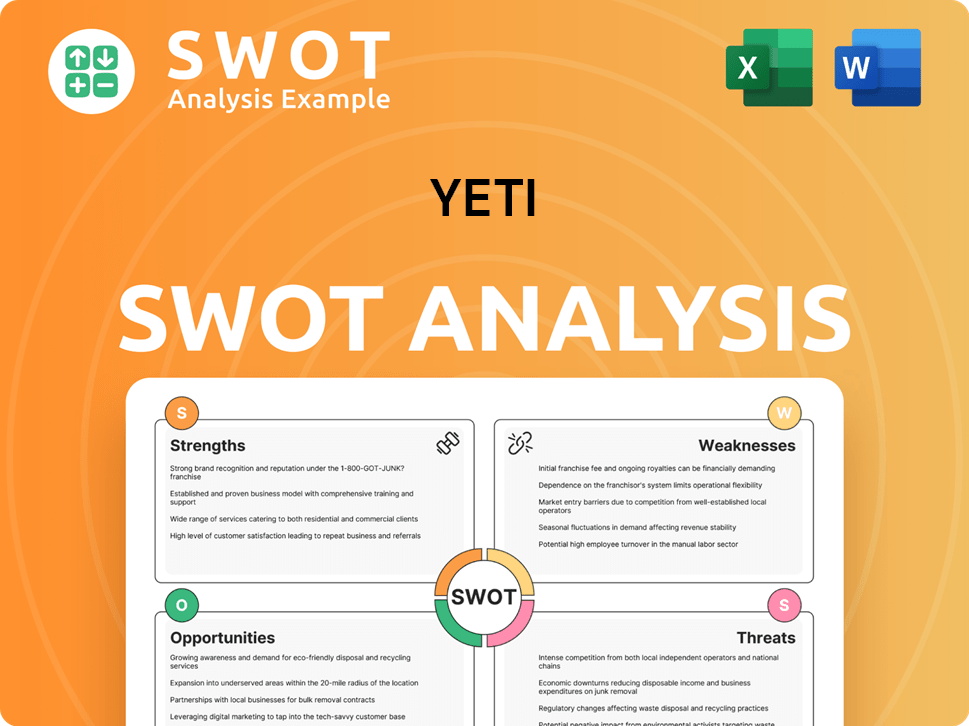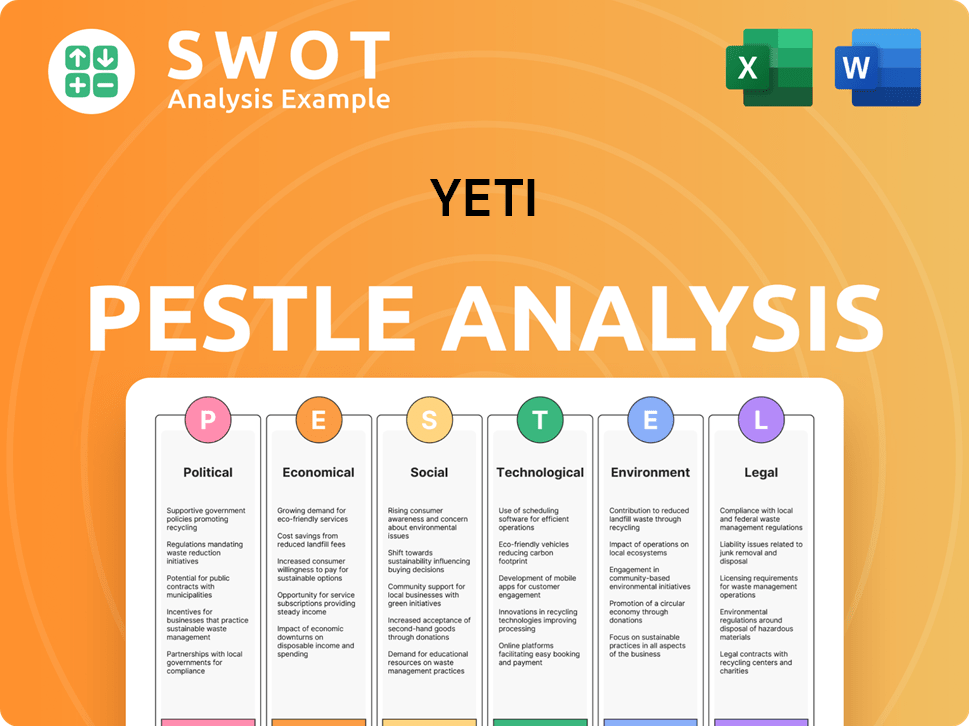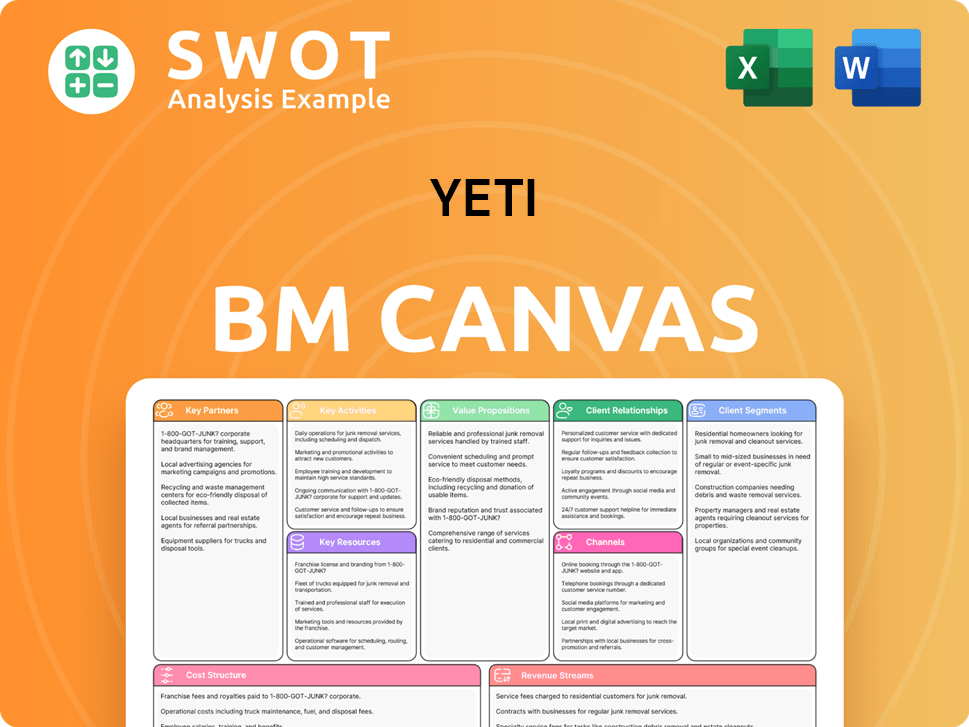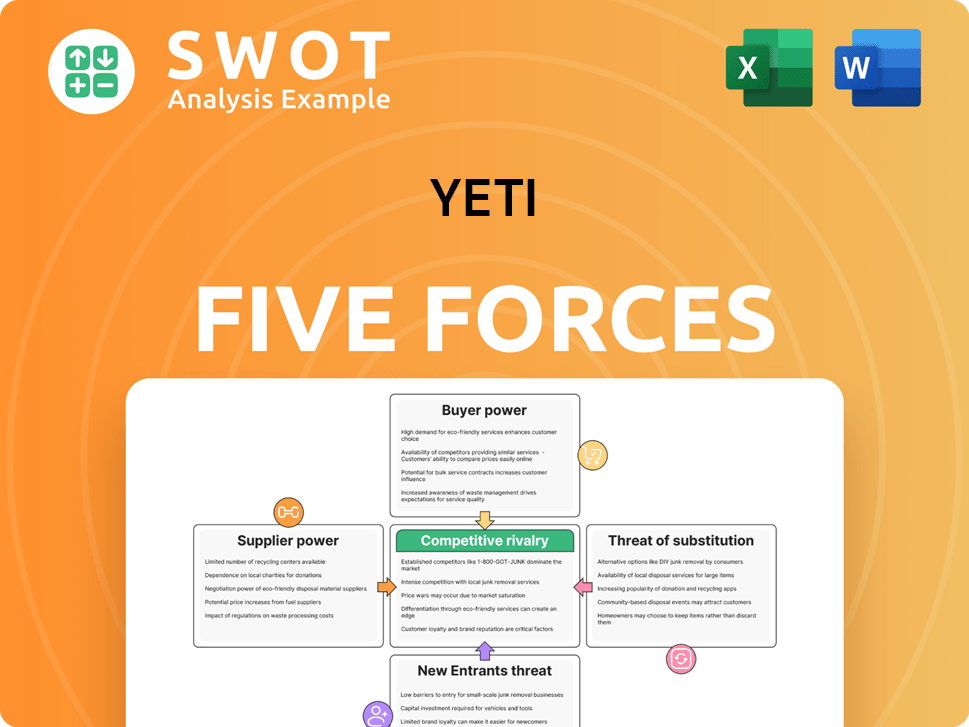YETI Bundle
Can YETI Maintain Its Dominance in a Crowded Market?
YETI, the titan of premium outdoor gear, has cultivated a loyal following, transforming coolers and drinkware into coveted lifestyle accessories. But with success comes competition. The YETI SWOT Analysis reveals a company navigating an increasingly complex market, where rivals are constantly vying for a piece of the pie.

This exploration of the YETI competitive landscape delves into the key players challenging its market position. We'll dissect YETI competitors, analyze their strategies, and assess the impact on YETI's market share in 2024 and beyond. Understanding the dynamics of the outdoor industry and the drinkware market is crucial for investors and strategists alike, offering insights into YETI's financial performance and future prospects.
Where Does YETI’ Stand in the Current Market?
YETI holds a premium market position within the outdoor and recreation sector, particularly in hard and soft coolers and insulated drinkware. While specific market share data for 2024-2025 is proprietary, YETI is recognized as a leader, especially in the premium segments of these categories. Its main product lines include Tundra hard coolers, Hopper soft coolers, and Rambler drinkware, alongside bags, apparel, and outdoor living products. The company mainly targets outdoor enthusiasts involved in activities like hunting, fishing, camping, and tailgating, as well as everyday consumers seeking durable, high-performance products.
YETI has strategically maintained its premium positioning, focusing on product quality, durability, and brand experience rather than competing solely on price. This approach allows the company to command higher price points and maintain healthy profit margins. Geographically, YETI has a strong presence in North America, its largest market, and is expanding internationally into regions like Australia, Europe, and Asia. The company's financial health remains robust, with net sales increasing by 8% to $401.9 million in the first quarter of 2024 compared to the prior year period. This growth is attributed to strong performance in both its Drinkware and Coolers & Equipment segments, with Drinkware net sales increasing by 13% and Coolers & Equipment net sales growing by 1%. This shows strong market presence and consumer demand for its products across its core categories.
YETI's competitive landscape is shaped by its premium brand positioning and focus on high-quality, durable products. The company competes with various brands in the outdoor industry, including both direct and indirect competitors. Understanding the YETI competitive landscape requires an examination of its key rivals and their respective market strategies. A comprehensive YETI market analysis reveals how the company differentiates itself through product innovation, brand loyalty, and targeted marketing efforts. For further insights into how YETI has achieved its market position, consider reading about the Growth Strategy of YETI.
YETI is a recognized leader in the premium cooler and drinkware markets. Its focus on high-quality products and strong brand recognition has solidified its position. The company's ability to maintain premium pricing reflects its brand value and customer loyalty.
YETI continuously innovates its product lines, introducing new features and designs to meet consumer demands. This includes advancements in insulation technology, material durability, and product functionality. New product launches and line extensions help maintain market relevance.
YETI cultivates strong brand loyalty through its focus on quality and customer experience. This loyalty allows the company to maintain premium pricing and withstand competition. Brand advocacy and positive customer reviews are key drivers.
YETI is expanding its international presence to diversify its revenue streams and reach new customer segments. This includes strategic growth in markets such as Europe and Asia. International expansion is a key component of its growth strategy.
The YETI competitive landscape is dynamic, influenced by consumer preferences, economic conditions, and competitor actions. Understanding these factors is crucial for strategic planning. The company’s ability to adapt to changing market conditions is critical for sustained success.
- Premium Positioning: YETI's focus on quality and durability allows it to maintain premium pricing.
- Market Growth: The outdoor recreation market continues to grow, providing opportunities for YETI.
- Competition: Increased competition from both established and new brands requires continuous innovation.
- Consumer Trends: Changes in consumer preferences, such as demand for sustainable products, impact YETI's strategies.
YETI SWOT Analysis
- Complete SWOT Breakdown
- Fully Customizable
- Editable in Excel & Word
- Professional Formatting
- Investor-Ready Format

Who Are the Main Competitors Challenging YETI?
The YETI competitive landscape is shaped by a diverse array of rivals vying for market share in the outdoor gear and drinkware sectors. These competitors employ various strategies, from offering lower prices to emphasizing brand heritage and product innovation, to challenge YETI's dominance. Understanding these competitors is crucial for assessing YETI's position and potential growth opportunities.
The YETI market analysis reveals a dynamic environment where established brands and emerging players constantly adapt to consumer preferences and market trends. This includes direct competitors like RTIC and ORCA, as well as broader outdoor gear manufacturers and drinkware specialists. The competitive pressure necessitates continuous innovation and strategic adjustments to maintain a strong market presence.
The outdoor industry is highly competitive, and the YETI competitors are constantly evolving. The company's financial performance and market share are closely watched by investors and analysts. For a deeper understanding of the company's marketing approach, you can explore the Marketing Strategy of YETI.
RTIC Coolers is a significant direct competitor, often offering similar products at lower prices. ORCA also competes in the premium cooler segment, emphasizing American-made products. These brands directly challenge YETI's market share by appealing to consumers seeking high-quality products at different price points.
Companies like Igloo and Coleman, traditionally known for budget-friendly options, have expanded into premium lines to compete with YETI. These brands leverage their existing distribution networks and brand recognition to gain market share. Their entry into the premium segment increases the competitive pressure on YETI.
Hydro Flask, owned by Helen of Troy, is a major player in the insulated drinkware market, known for its strong brand presence. Stanley has also seen a resurgence with its Quencher tumbler, directly competing with YETI's drinkware. These competitors challenge YETI in a specific product category.
Emerging players and private label brands leverage e-commerce platforms to offer competitive pricing. These competitors often focus on specific niches or product features to attract customers. The rise of these brands highlights the dynamic nature of the market.
Competitors employ strategies such as product innovation, expanded distribution, and refined branding. The success of the Stanley Quencher demonstrates how competitors can quickly gain market share. YETI must continuously innovate and adapt its strategies to maintain its market position.
The competitive landscape is dynamic, with companies constantly innovating. The rise of competitors like Stanley shows how quickly the market can change. YETI's ability to adapt and innovate is crucial for its long-term success.
Several factors influence the YETI competitive landscape, including pricing strategies, product features, brand positioning, and distribution channels. Understanding these factors is essential for evaluating YETI's performance and identifying potential threats and opportunities.
- Pricing Strategies: RTIC Coolers often undercuts YETI's prices, appealing to cost-conscious consumers.
- Product Features: Competitors innovate with features like enhanced insulation, durability, and design aesthetics.
- Brand Positioning: Hydro Flask targets a younger demographic with vibrant colors, while Stanley leverages its heritage.
- Distribution Channels: E-commerce platforms and retail partnerships are key for reaching consumers.
YETI PESTLE Analysis
- Covers All 6 PESTLE Categories
- No Research Needed – Save Hours of Work
- Built by Experts, Trusted by Consultants
- Instant Download, Ready to Use
- 100% Editable, Fully Customizable

What Gives YETI a Competitive Edge Over Its Rivals?
Understanding the Owners & Shareholders of YETI is crucial to grasping its competitive advantages within the outdoor industry. The company's success isn't just about making coolers; it's about building a brand that resonates with a lifestyle. This approach has allowed it to maintain a premium pricing strategy, setting it apart in the cooler brands and drinkware market.
The YETI competitive landscape is shaped by its strong brand recognition and commitment to product quality. Consumers often view YETI products as investments due to their perceived durability and performance. This perception allows YETI to compete effectively against both established and emerging rivals, maintaining a loyal customer base that values its products.
YETI's strategic focus on innovation and its direct-to-consumer (DTC) channel further solidify its position. By continuously refining its products and expanding its DTC presence, YETI strengthens its control over its brand message and customer experience, which is vital in a competitive market. The company's ability to adapt and innovate is key to its ongoing success.
YETI has cultivated a powerful brand that symbolizes the outdoor lifestyle. This strong brand recognition fosters exceptional customer loyalty. Consumers are willing to pay a premium for YETI products, viewing them as investments due to their perceived longevity and performance.
The company continually refines its existing products and introduces new ones. YETI leverages proprietary technologies and materials to enhance performance, insulation, and user experience. The design and engineering of its hard coolers, with their rotomolded construction, and its vacuum-insulated drinkware, have set industry benchmarks.
YETI's strategic shift and expansion of its DTC channel have significantly strengthened its competitive position. In the first quarter of 2024, DTC net sales increased by 7% to $220.4 million, representing 55% of total net sales. This channel provides higher margins compared to wholesale.
YETI's competitive advantages include strong brand equity, product quality, and a robust DTC channel. These factors enable YETI to maintain premium pricing and customer loyalty. The company's focus on innovation and direct customer engagement further strengthens its market position.
YETI's competitive advantages are rooted in its brand, product quality, and DTC strategy. These elements allow YETI to maintain a strong market position. The company's ability to innovate and connect directly with consumers is crucial.
- Brand Strength: YETI has cultivated a powerful brand that resonates with the outdoor lifestyle, fostering customer loyalty and premium pricing.
- Product Quality and Innovation: Continuous product refinement and the use of proprietary technologies enhance performance and user experience.
- Direct-to-Consumer Channel: DTC sales provide higher margins and enable YETI to control its brand message and customer experience.
- Financial Performance: In Q1 2024, DTC net sales increased by 7% to $220.4 million, representing 55% of total net sales, highlighting the channel's importance.
YETI Business Model Canvas
- Complete 9-Block Business Model Canvas
- Effortlessly Communicate Your Business Strategy
- Investor-Ready BMC Format
- 100% Editable and Customizable
- Clear and Structured Layout

What Industry Trends Are Reshaping YETI’s Competitive Landscape?
The outdoor and recreation industry is dynamic, with trends significantly impacting companies like YETI. Understanding the YETI competitive landscape requires an analysis of these industry shifts, potential risks, and future opportunities. This includes examining YETI competitors and their strategies within the broader outdoor industry and drinkware market.
Key factors influencing YETI's position include consumer preferences for sustainable products and technological advancements. YETI market analysis reveals that the company must adapt to these changes to maintain its competitive edge, considering both internal strengths and external challenges.
A major trend is the growing demand for sustainable and eco-friendly products. Consumers are increasingly seeking items made from recycled materials and produced with sustainable processes. Technological advancements in insulation and smart features are also reshaping the market, presenting opportunities for innovation.
Intensified competition from lower-priced alternatives and new direct-to-consumer brands poses a significant challenge. Economic downturns could also affect consumer spending on premium outdoor goods. Adapting to evolving consumer preferences, such as the demand for lighter and more portable gear, is crucial.
Significant growth opportunities exist in international expansion, especially in emerging markets. Further product line diversification into adjacent outdoor categories can also fuel growth. Focusing on brand building and expanding direct-to-consumer reach are essential strategies.
YETI's strategy should involve continued investment in brand building, product innovation, and expanding its direct-to-consumer reach. Exploring sustainable practices and adapting to evolving consumer demands are also critical for long-term success. Analyzing YETI's strengths and weaknesses is key.
The YETI competitive landscape is complex, with various players vying for market share. Key competitors include RTIC, Orca, and Hydro Flask. These companies compete on price, product features, and brand recognition. For a detailed comparison of competitors, consider reading about the 0.
- YETI vs RTIC: RTIC often offers lower prices, appealing to budget-conscious consumers.
- Cooler brands: Brands like Orca focus on durability and ruggedness, appealing to a different segment of the market.
- YETI market share 2024: While specific market share data for 2024 is still being compiled, YETI continues to hold a significant position.
- YETI competitor pricing strategies: Competitors employ various pricing strategies, including value-based pricing and promotional offers, to attract customers.
YETI Porter's Five Forces Analysis
- Covers All 5 Competitive Forces in Detail
- Structured for Consultants, Students, and Founders
- 100% Editable in Microsoft Word & Excel
- Instant Digital Download – Use Immediately
- Compatible with Mac & PC – Fully Unlocked

Related Blogs
- What are Mission Vision & Core Values of YETI Company?
- What is Growth Strategy and Future Prospects of YETI Company?
- How Does YETI Company Work?
- What is Sales and Marketing Strategy of YETI Company?
- What is Brief History of YETI Company?
- Who Owns YETI Company?
- What is Customer Demographics and Target Market of YETI Company?
Disclaimer
All information, articles, and product details provided on this website are for general informational and educational purposes only. We do not claim any ownership over, nor do we intend to infringe upon, any trademarks, copyrights, logos, brand names, or other intellectual property mentioned or depicted on this site. Such intellectual property remains the property of its respective owners, and any references here are made solely for identification or informational purposes, without implying any affiliation, endorsement, or partnership.
We make no representations or warranties, express or implied, regarding the accuracy, completeness, or suitability of any content or products presented. Nothing on this website should be construed as legal, tax, investment, financial, medical, or other professional advice. In addition, no part of this site—including articles or product references—constitutes a solicitation, recommendation, endorsement, advertisement, or offer to buy or sell any securities, franchises, or other financial instruments, particularly in jurisdictions where such activity would be unlawful.
All content is of a general nature and may not address the specific circumstances of any individual or entity. It is not a substitute for professional advice or services. Any actions you take based on the information provided here are strictly at your own risk. You accept full responsibility for any decisions or outcomes arising from your use of this website and agree to release us from any liability in connection with your use of, or reliance upon, the content or products found herein.